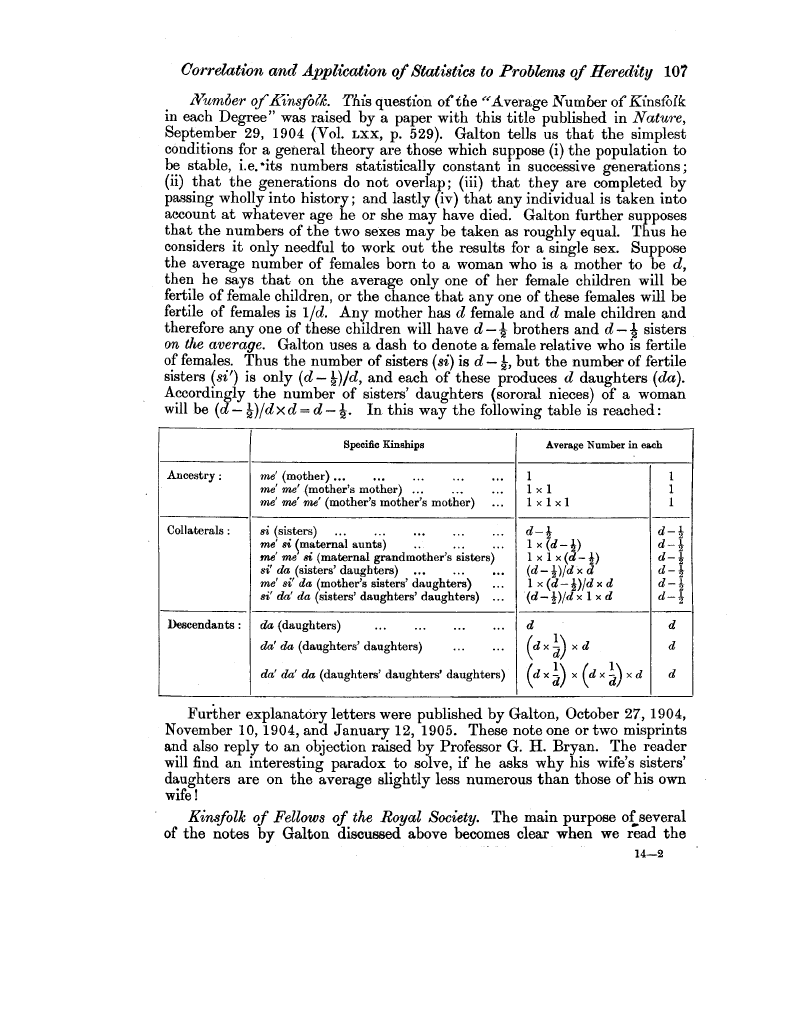Correlation and Application of Statistics to Problems of Heredity 107
tVum7er of Kinsfolk. This question of the "Average Number of Kinsfolk in each Degree" was raised by a paper with this title published in Nature, September 29, 1904 (Vol. LXX, p. 529). Galton tells us that the simplest conditions for a general theory are those which suppose (i) the population to be stable, i.e.*its numbers statistically constant in successive generations; (ii) that the generations do not overlap; (iii) that they are completed by passing wholly into history; and lastly (iv) that any individual is taken into account at whatever age he or she may have died. Galton further supposes that the numbers of the two sexes may be taken as roughly equal. Thus he considers it only needful to work out the results for a single sex. Suppose the average number of females born to a woman who is a mother to be d, then he says that on the average only one of her female children will be fertile of female children, or the chance that any one of these females will be fertile of females is 1/d. Any mother has d female and d male children and therefore any one of these children will have d - Q brothers and d - 2 sisters on the average. Galton uses a dash to denote a female relative who is fertile of females. Thus the number of sisters (si) is d - Q, but the number of fertile sisters (si') is only (d - 2)/d, and each of these produces d daughters (da). Accordingly the number of sisters' daughters (sororal nieces) of a woman will be (d - 1)1d x d = d - -1. In this way the following table is reached
| |
Specific Kinships |
Average Number in each |
|
Ancestry : |
me' (mother) ... ... ... ... ... |
1 |
1 |
| |
me' me' (mother's mother) .. .. ... |
1 x 1 |
1 |
| |
me' me' me' (mother's mother's mother) ... |
1 x 1 x 1 |
1 |
|
Collaterals : |
si (sisters) ... ... ... ... ... |
d - 2 |
d-1 |
| |
me' si (maternal aunts) .. ... ... |
1 x (d- 2) |
d - 2 |
| |
me' me' si (maternal grandmother's sisters) |
1 x 1 x (d- 2) |
d - 2 |
| |
si' da (sisters' daughters) ... ... ... |
(d - 2)/d x d |
d - 2 |
| |
me' si da (mother's sisters' daughters) ... |
1 x (d - 2)/d x d |
d - 2 |
| |
si da' da (sisters' daughters' daughters) ... |
(d-2)/d x 1 x d |
d-2 |
|
Descendants : |
da (daughters) ... ... ... ...
da' da (daughters' daughters) ... ...
da da' da (daughters' daughters' daughters) |
d
(d x ~ x
(d x d) x (d x x d |
d
d
d |
Further explanatory letters were published by Galton, October 27, 1904, November 10, 1904, and January 12, 1905. These note one or two misprints and also reply to an objection raised by Professor G. H. Bryan. The reader will find an interesting paradox to solve, if he asks why his wife's sisters' daughters are on the average slightly less numerous than those of his own wife!
Kinsfolk of Fellows of the Royal Society. The main purpose of several of the notes by Galton discussed above becomes clear when we read the
14-2
